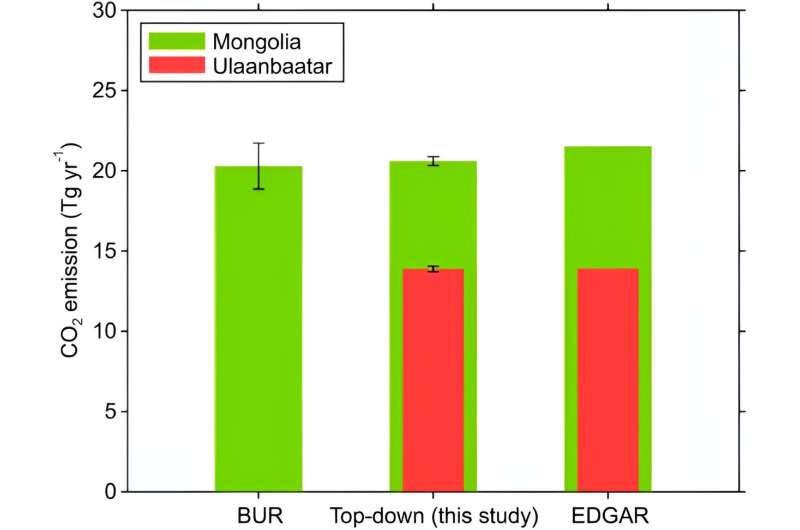This article has been reviewed according to Science X's editorial process and policies. Editors have highlighted the following attributes while ensuring the content's credibility:
fact-checked
peer-reviewed publication
trusted source
proofread
A cost-efficient and transparent method to measure carbon dioxide emission estimates using GOSAT

Researchers in Japan and Mongolia have carried out the world's first instance of incorporating satellite-based CO2 emission estimates into a GHG emission report as the verification on the Second Biennial Update Report (BUR2) of Mongolia submitted to the UNFCCC on 15 November 2023, resulting in high accuracy match with actual reported values, reports a new study published online in Scientific Reports in 2023.
Countries have reported their CO2 emissions to the UNFCCC, primarily from human activities and a significant contributor to climate change. The method adopted for this reporting is based on detailed statistical data. However, some nations have faced challenges reporting due to a lack of data and experts.
A research team from Chuo University, Japan, the Information and Research Institute of Meteorology, Hydrology and Environment, Mongolia, and the Ministry of Environment and Tourism, Mongolia, led by Chuo University Institute Professor Masataka Watanabe, developed an approach that utilizes satellite observations of greenhouse gases (GHGs) in the atmosphere.
Their hybrid system, integrates the atmospheric transport models, inverse analysis, and socio-economic methods which estimated national CO2 emissions by inputting GOSAT satellite data.
"We sought to measure the CO2 emissions of Mongolia's energy sector accurately by developing a novel hybrid system distinct from previous methodologies. This hybrid system capitalizes on the advantages of the conventional bottom-up approach, which uses statistical data, and the top-down approach, which employs satellite data."
"This research aimed to verify how closely the CO2 emissions from Mongolia, as determined by the hybrid system, align with values obtained using existing methods, thereby demonstrating the effectiveness of this new system," said lead author and Institute Professor Masataka Watanabe.
"This method provides a complete picture of GHG dynamics regarding its spatial and temporal distribution, with indication of sources and removal, as well. It is essential for countries like Mongolia, where the landscape features by complex topography as a precondition to occur more localized factors for GHG dispersion, such as a temperature inversion."
"Remote sensing information like GOSAT data for interpretation of, which uses a more sophisticated methodology, as presented here, is an essential, cost-effective, and transparent tool for climate change study and for establishing a stable GHG monitoring system in Mongolia, which is a more sparsely populated and limited human resources country," said Dr. Batjargal Zamba, the former special envoy for climate change in Mongolia.
The research team conducted targeting observations of Ulaanbaatar city in Mongolia using GOSAT. When applying the hybrid system to calculate the CO2 emissions of Mongolia's energy sector, the team's results showed a few percentages of differences from the traditional values reported by the Mongolian government, and the global GHG emission database "The Emissions Database for Global Atmospheric Research (EDGAR)".
These findings demonstrate the effectiveness of the hybrid system in estimating CO2 emissions and indicate that Mongolia's calculation of CO2 emissions in the energy sector aligns closely with accurate estimates. This result suggests a scientifically transparent and high-quality report.
More information: Masataka Watanabe et al, Enhancing scientific transparency in national CO2 emissions reports via satellite-based a posteriori estimates, Scientific Reports (2023). DOI: 10.1038/s41598-023-42664-3
Journal information: Scientific Reports
Provided by Chuo University



















